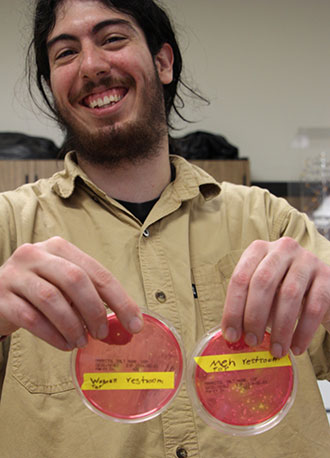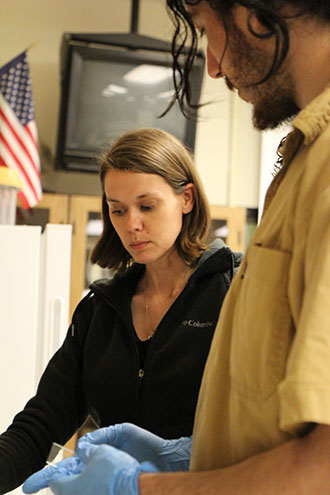Science club members examine bacteria growth

Every time a student, faculty member or teacher touches a computer keyboard, desk or chair, they are coming in close contact with a vast, invisible world. Turn a doorknob and more than just a door gets opened. Shake a hand, accept some change, or pick up a book and there is an exchange of bacteria and other forms of microbial life. Yet few consider how many different forms of this microscopic menagerie exist on the surfaces of tables, chairs and vending machines.
Enter Jorge and Teresita Nader, siblings and science club enthusiasts. The brother and sister team have been collecting samples for several weeks from all around campus, and recently compiled the results of their research.
“We were brainstorming and some of the students in the club were interested to know what kind of bacteria was around the campus,” Jorge Nader said, “So I said why not cultivate some bacteria for the places we touch more for the sake of knowing what we interact with every day.”

The Naders took swab samples from a variety of locations: Computer keyboards, desktops and both men’s and women’s bathrooms. Teresita Nader also had a very specific location in mind.
“I usually use the vending machine, so I was interested in what I touch every day, “Teresita Nader said. “I hoped to see if the vending machine was clean, but it was actually not so clean. I learned what different types of bacteria exist, I didn’t know they were in so many different shapes.”
Becky Chappel, science lab technician for UCC, felt the experience was a positive one for the Naders and for the school.
“I think it’s a great experience for them, to look at their environment and want to investigate some microbiology. It’s great for the science club to want to branch out,” Chappel said.
Ken Carloni, head of the science department, likewise agreed about the positive outcome of the experiment, but cautioned against reading too much into the results.
“They are finding bacteria. They found bacteria in different places,” Carloni said, “Even if its Staph Aureus and E. coli, the vast majority of strains of those two organisms are benign. One shouldn’t get too alarmed about finding either of those two things in those places.”
“But on the other hand it is always a good reminder to follow standard hygiene: Wash your hands and make sure you’re aware of where you put them. We have lots of Purell outside most doors. It’s always a good reminder that hand-washing is a good thing,” Carloni said.

When the results were compiled, the findings were mostly positive. While bacteria was found at almost every location, they were mostly a benign variety, and in very small numbers. The library keyboard sampled had a combination of Staphylococcus, Corynebacterium and lactobacillus. As was expected, there were higher number of bacteria in the bathrooms, but were also mostly of a non-harmful variety. The men’s bathrooms had almost double the number of bacteria compared to the women’s, according to the Nader’s research. The library vending machine had higher levels of bacteria, but it was primarily Micrococcus, a harmless resident commonly found on human skin.
Overall, the experiment found that most of the locations had normal, non-threatening amounts of bacteria on them. The vending machine, on the other hand, is used by a large amount of people every day, and short of it receiving multiple cleanings every day, will probably continue to be a source of elevated bacteria levels.
Carloni cautioned that while the results of this test might seem worrisome, they are actually well within the normal range and not a cause for alarm.
“There are thousands of types of microbes in and on our bodies. Of the 100 trillion cells contained in the human body, only about 10 trillion belong to us. They are mostly beneficial from the standpoint that they are benign and occupy niches that might otherwise be taken up by pathogenic microbes.” Carloni said.
Bacteria are everywhere in the world and the large proportion of them are either neutral or beneficial to humans. There is no way to eliminate even the malignant varieties. The best way to avoid infectious disease is dedication to personal hygiene: frequent hand-washing, avoiding contaminated surfaces and being conscientious when ill.
